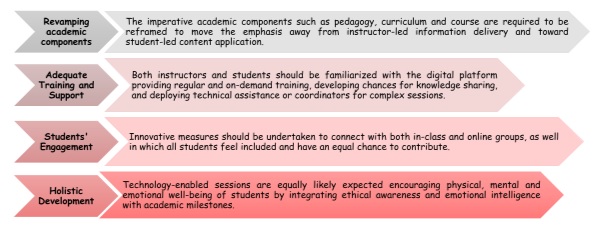The world has adapted many ‘New Normal’ outcomes generated in the light of pandemic COVID-19. Thanks to the advanced Information and technology practices, that have evolved as backbone to renovate the traditional education sector and made it realize its actual potency. Our education administration has shown its unbelievable agility to get trained and leverage the latest technologies in using online platforms to deliver Quality Education and bring the reforms according to the recommendations of NEP 2020 in this challenging time. Blended and Hybrid learning are also the modifications embraced by the Education system to avoid uninterrupted learning in the time of uncertainties.
Difference between Hybrid and Blended Learning
The terms Blended learning and Hybrid learning are used interchangeably most of the time as both incorporate technology in teaching-learning practices to operate efficiently. However, the difference lies in the way to deploy the technological measures; Blended learning is concerned with leveraging technology in classroom learning activities to make the concept clearer and more understandable, while Hybrid learning model is the use of technology to make simultaneous learning sessions available for both the students present in the classroom as well as those present at their own place.
Blended learning is not new model to be adopted, UGC has always put its best efforts to integrate technology in teaching-learning measures of Higher Education System but Pandemic has pushed to implement the same with no other option left whereas Hybrid learning model is an evolved learning model which makes the learning free from any physical barriers by using the digital platform effectively to open the way to explore new technologies to build upon the digital strengths and achieve the learning outcomes.
Higher Education Institutes are required to take a few measures as mentioned below, for the operative implementation of constructive Blended/Hybrid learning that can ensure the quality teaching-learning experience

The Online Education System deployed in that time of emergency has made the world reimagine the unthinkable Education practices and future possibilities of using digital tools and technologies to make quality learning available to the student at every part of the globe. NEP 2020 has also advocated some visionary actions to promote the utilisation of technology in teaching-learning methods at Higher Education Institutes. It has recommended incorporating national digital platforms like SWAYAM and DIKSHA to foster multidisciplinary and flexible learning. The establishment of Virtual labs will also encourage hybrid/blended learning in Higher Education Institutes to offer equal access to excellent experiment-based knowledge.
NEP has also emphasised the role of special training and incentives for faculty members to motivate the student-centric learning and advanced pedagogical practices. It has fostered the development of an open, interoperable technology-based infrastructure in the education sector that can provide solutions to the country’s major difficulties, such as India’s size, variety, complexity and improve the digital divide constraints in learning.
Experts have stated that the use of technology driven learning and online platforms will continue to be appreciated and implemented in the post-pandemic Education landscape. Higher Education Institutes are fostered to develop their digital capabilities and explore the benefits of deploying Blended and Hybrid learning model given as:
For the Students:
- Flexible and Self-paced learning
- More engaging sessions than chalk and board ones
- Can govern their own learning.
- Can follow their learning trajectory.
For the Faculty:
- Can be more collaborative and creative than classroom sessions
- Can easily track the learning milestones.
- Can be more time saving than manual handling of academic functions.
- Can experiment with more pedagogical practices for deeper learning.
For the Administrators:
- Can be labour-saving than manual administration.
- Can easily train and upskil the instructors.
- Can have a bird-eye view of academic and non-academic operations anytime and anywhere.
- Better course and faculty management.
Although,the transition of incorporating technology in Education practices brings lot of advantages for every stakeholders yet Higher Education Institutes should prepare themselves to address a few challenges along with such as digital infrastructure that consists of advanced and collaborative digital tools and services to create a secure and updated experience, regular training and support for instructors and students to use updated digital platform and technologies etc.
Therefore a strong technology foundation has become the need of the hour for Higher Education Institutes for achieving the learning goals of the 21st century education system.
iCloudEMS has always taken the utmost care of digital needs of Higher Education Institutes in order to host a digital ecosystem and support student-centered learning. We have always extended our utilities to empower uninterrupted learning experience in every situation. Our primary characteristics that address the technological requirements in the course of implementing Blended and Hybrid learning models in Higher Education Institutes are listed below.
- Cloud-based platform for seamless management of massive data and reports.
- Specialized managed services for the sustenance of Higher Education Institutes’ ERP systems, that brings digital transformation in handling administrative and non-administrative operations in Colleges and Universities.
- We make the course choice and allotment sample for faculty and students under the framework of Choice based Credit System.
- We provide a cloud-based personalised Learning management system to increase student engagement and encourage advanced pedagogy in the teaching-learning.
- Students can access the study material through an online repository using their login credentials, allowing them to learn at their own speed and bridging learning gaps.
- At the end of each topic, rating and feedback systems aid instructors in gaining insights into students’ learning curves and strategic planning of their pedagogical approaches.
- Our interactive Learning Management System (LMS) supports a variety of multimedia formats to help students visualize concepts better.
- Outcome-based education (OBE) has become a must-have for achieving learning objectives. Our outcome-based LMS links teaching and assessment procedures with OBE and Bloom’s taxonomy to assist teachers in the definitive assessment of cognitive abilities of students.
- One of the most essential aspects of education transformation is on-demand examination. The Online Exam Management system provides a disciplined environment for the planning and governance of on-demand examinations while maintaining system integrity.
- Our specialised Student lifecycle management system promotes student-centered learning by integrating a student’s entire academic journey onto a single dashboard that provides an overhead view of the students’ activities and progress, allowing for more efficient tailoring of future plans for students’ overall development.
It can be summarized that in this world of uncertainties, we all are required to learn the way to survive in the digital ecosystem. The fundamental necessity is to strengthen the digital infrastructure of Higher Education Institutes for enriched quality education management without any time or space constraints. Blended and Hybrid learning are tech-integrated models that nourish the 21st century skills in the students in a multidisciplinary culture. iCloudEMS digitally facilitates the organizational and administrative arrangements of Higher Education Institutes to support student-centric and flexible learning that can fulfil the learning preferences and needs of the modern era youth.

